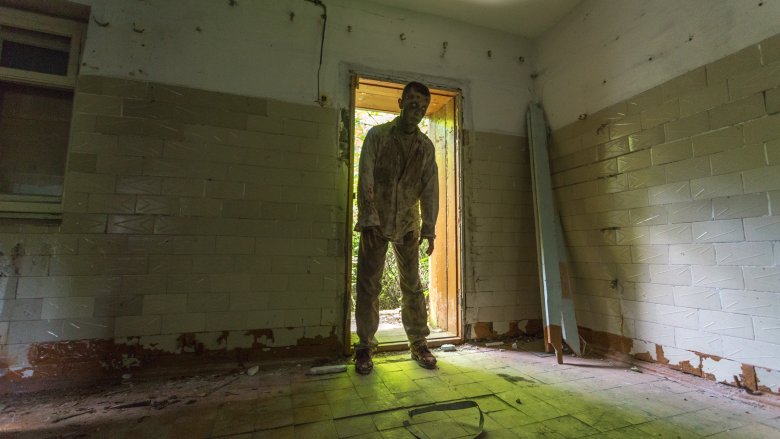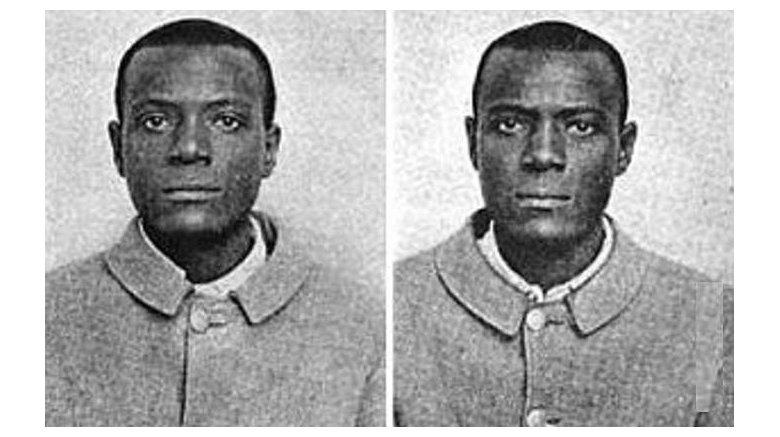The Craziest Instances Of Mistaken Identity
Not so very long ago, if someone thought you were someone you weren't, you were kind of, shall we say, twisted into a small hole by a Phillips screwdriver. There was no DNA testing, there was no fingerprinting, and there was no appealing your sentence, either. So your best defense against being mistakenly identified as someone you weren't was to live in a cave and avoid all contact with other humans.
Even today, cases of mistaken identity sometimes lead to some pretty crazy situations — the only real difference is that today when someone is very sure you're the guy who killed Sheriff Moore, spit on him, and stole $4,000 from his house, a simple mouth swab can usually clear that up. Unless you get hanged before the DNA results are in. And as anyone who's ever sent a sample to 23andMe can tell you, that can take for-freaking-ever.
James Stewart and Thomas Berdue
"English Jim" was the sort of outlaw they make movies about. He was so obnoxious that he got kicked out of England and then embarked on a life of crime in the U.S. that included such mischief as killing a bunch of gold miners, stealing money, murdering the sheriff, and escaping from jail.
Instead of lying low for a while after his escape, English Jim went on to assault and rob more people, until he was finally apprehended in February 1851. Except it wasn't him, it was some other guy who had the great misfortune of looking exactly like English Jim. According to Crime Magazine, English Jim had a scar above his left eye and was missing the tip of his left forefinger. In addition to having a similar face, his unfortunate doppelganger had the exact same identifying marks.
Despite insisting to authorities that they had the wrong man, Thomas Berdue was tried and convicted for English Jim's crimes — which is not that shocking when you consider that pretty much everyone in the history of crime has mostly insisted that authorities have the wrong man, so it's not like he was really covering new territory as far as his defense was concerned.
Fortunately for Berdue, English Jim didn't stop committing crimes just because someone else was going to be executed in his place. He was eventually captured, and he confessed and was subsequently hanged, just in time for Berdue to avoid the same fate.
Whitney Cerak and Laura Van Ryn
Mistaken identity isn't always a case of whodunit. Sometimes there can be medical mix-ups that have tragic consequences — or miraculous ones, depending on your perspective. We've all heard stories of babies switched at birth, which is sort of understandable because let's face it, babies kind of all look the same. But when kids get older, that sort of mistake can't happen. Except that it did — to Whitney Cerak and Laura Van Ryn.
According to the Washington Post, the two women were on their way home from a college trip when a semi truck hit the van they were traveling in. Van Ryn was killed instantly and Cerak survived with a brain injury and broken bones. Paramedics found Van Ryn's purse near Cerak, and because the two women looked similar and because Cerak's injuries were so severe, she was misidentified.
Cerak's parents were told their daughter was dead, and Van Ryn's parents rushed to what they thought was their child's bedside. The woman was in a coma, her face was swollen and bandaged, and the Van Ryns had no reason to question her identity. It wasn't until five weeks after the accident when she woke and was asked to write her name that they learned they'd been keeping vigil at a stranger's bedside. The equal parts awfulness and wonderfulness of this story are pretty difficult to comprehend, but can be summed up in the words of Cerak's sister: "It is hard because our joy is their pain."
Emelyan Pugachev and Peter III
Getting mistaken for royalty isn't just something that happens in Mark Twain novels and Garfield movies, there were real-life instances of this kind of mix-up, too, which mostly happened because (aside from the "no DNA tests" thing) there were no television cameras to broadcast the face of the real emperor to anyone who wanted to stay out of his fake rebellion.
Although popular legend says Emelyan Pugachev resembled Peter III, he probably didn't — according to Erenow he didn't have to because most of the Cossacks, peasants, runaway serfs, and random other people who thought Russia's Catherine the Great was not actually that great had never even seen Peter III. Most of them just needed an excuse to band together, and former soldier Pugachev was just what they were looking for. In 1773 he showed up on the steppes near the Volga River and said, "Hey Cossacks, I'm Peter III and I'm not really dead. Now, let's go take down the empress." And the Cossacks said, "Cool," and a rebellion was born.
Pugachev took out several cities during the brief rebellion, but he kept getting his butt kicked and was eventually betrayed by his own people and captured in the summer of 1774. And so things didn't end very well for the false Peter III, who ended up on the chopping block in Bolotnaya Square.
Gilberto Araujo and Genivaldo Santos Gama
A Brazilian car washer named Gilberto Araujo was literally walking down the street, minding his own business, when a guy he knew approached him and said, "Hey, did you know you're dead and your family is going to your funeral?" And Araujo patted himself down and said, "I don't actually think I'm dead," and his friend said, "There's a coffin and you're in it," and then Araujo said, "I don't think so" and decided maybe he ought to go sort some things out.
According to the BBC, Araujo crashed his own funeral, and people started screaming and running away just as you probably would, too, if the zombie apocalypse suddenly became a reality at your friend's funeral.
So what was the deal with the dead guy who wasn't really dead? Well there was actually a body in the coffin, and it was actually the body of someone who washed cars for a living, and it just so happened that dead car-washing guy looked enough like Gilberto Araujo that Araujo's brother misidentified the corpse. Now while it's true that zombies are fun and totally en vogue, it seems like the news could have been broken in a less terrifying way. Maybe Araujo's acquaintance could have gone to the funeral first and warned mourners that the next person to walk through the door was not, in fact, the reanimated corpse of dear departed Gilberto. Just a thought.
Bobby Dunbar and Bruce Anderson
In 1912, a 4-year-old boy named Bobby Dunbar disappeared during a family camping trip at an alligator-infested lake near Opelousas, Louisiana. Now the first rule of camping is that you don't go to alligator-infested lakes, but this was 1912 so maybe they didn't see the Yelp reviews. Anyway, Bobby disappeared and despite frantically searching and also cutting open a bunch of alligators to check their insides, the boy was never found. But that's not the end of the story.
According to Mental Floss, eight months later, a transient was spotted with a boy who resembled Bobby. The authorities were called, a man named William Walters was apprehended as the "kidnapper," and the Dunbars kind of sort of identified the boy as their son, which was evidently enough for authorities. The fact that Walters insisted the boy was Bruce Anderson, the son of a friend, didn't seem to phase anyone, because transients can't be trusted.
The boy grew up with the Dunbars, and it wasn't until Bruce-Bobby's son decided to get a DNA test that the truth finally came out. Bobby Dunbar hadn't been returned to his family; Bruce Anderson had been taken away from his.
Weirdly, Bruce's own mother hadn't done much in the way of protesting — some people speculate that she was having a hard time caring for him and thought he'd be happier with the wealthy Dunbars. So it was a win-win. A bizarre, utterly tragic, sort of sickening win-win.
Arthur Eichele and some random turkey
Here's a tip: If you're going to disguise yourself as a turkey to hunt turkeys, don't do such an awesome job at it that a predator might mistake you for a turkey.
In 1992, 27-year-old hunter Arthur Eichele was camouflaged on a brushy slope overlooking California's Englebright Reservoir with his turkey decoy and his turkey call. When you blow on a turkey call, it makes a sound roughly equivalent to the Turkese words for "come eat me." But the turkey call and the turkey decoy did not attract any turkeys — instead, a hungry mountain lion happened along and said to itself, "Thanksgiving!"
The lion pounced on Eichele, batted at him a few times like a ball of yarn, and then fled, probably just as soon as it realized that the flailing, shouting turkey it had just attacked was actually a dude.
"I think it was (a case of) mistaken identity," Fish and Game Department wildlife investigator Bill Clark told the LA Times. "Once the cat realized it wasn't a turkey, it took off." Authorities decided not to track down the lion, since it made an innocent mistake and probably didn't pose a real threat to anyone who wasn't dressed like a turkey.
Guy who was in jail and guy who wasn't in jail
In the early 2000s, an Alaskan man courageously saved the life of his brother by donating bone marrow. Both men then went off into the world and started behaving like jerks. Brother One (the transplant recipient) ended up in jail for his indiscretions. Brother Two (the donor) decided to make up for everything altruistic he'd ever done by raping someone.
According to the BBC, DNA collected at the crime scene was matched to the blood of the first brother, but authorities were baffled because the first brother was in jail at the time of the assault. Digging deeper, they found a second match — a man with the same last name as the jailed man.
Here's something they don't tell you when you get a bone marrow transplant: From that day forward, your blood DNA profile will be identical to your donor's blood DNA profile, which means that authorities checking blood samples might think you and your donor are the same person. "A bone marrow transplant turns the patient into a chimera," writes geneticist Azita Alizadeh. A chimera is a person who has two different DNA profiles in the same body.
All of this could have been avoided if Alaskan authorities had used cheek swabs instead of blood DNA, but either way this story highlights an important point — even DNA isn't always a fail-safe way of identifying a person. How's that for unsettling?
Alondra Luna Nunez and Alondra Diaz Garcia
Identical first names and the presence of a roughly similar scar. Those two things were apparently enough to convince Mexican authorities that they ought to drag a teenage girl out of her classroom and ship her off to a foreign country to be reunited with someone she'd never met before.
Alondra Luna Nunez had been mistakenly identified as Alondra Diaz Garcia, who had been abducted in 2007 and taken illegally to Mexico by her father. It's hard not to feel sympathy for the missing girl's mother, but according to Sky News, Nunez was taken from her parents despite the fact that they were able to produce more than a dozen documents that proved her identity, and despite the fact that the scar on the bridge of her nose wasn't even in the same place as the missing girl's scar.
What's really bizarre about this story is why authorities decided to snatch the girl from her school and send her to the U.S. first and then have her take a DNA test later. It seems like they could have avoided an awful lot of trauma if they'd made a point of actually positively identifying her before flying her out of Mexico. Maybe they tried, but they got tired of waiting for 23andMe to process the danged samples. But whatever, at least the girl got an all-expenses paid trip to scenic Houston. (Sarcasm.)
Adolf Beck and John Smith
The late 1800s was a rough time to be a doppelganger, especially in the U.K., where you had to be super polite when you were insisting to authorities that they'd arrested the wrong man.
According to Forejustice, in 1896 a man named Adolf Beck was convicted of check fraud. The case against him was mostly based on eyewitness testimony — several women claimed he'd swindled them out of expensive jewelry with fake checks and a charming personality. The problem, which for some reason no one saw as a problem, was that the man they were looking for was not Adolf Beck, it was John Smith. But Beck was convicted anyway and served more than five years in prison, which must have been pretty sucky. Then he was convicted again in 1904 for another of Smith's crimes, which must have been doubly sucky.
Happily, the real John Smith was eventually arrested, and the women who'd fingered Beck all said, "Oops" and admitted they'd been wrong. Beck got a pardon and £5,000 as compensation, but the best thing to come out of the whole super-sucky situation was the U.K. Criminal Court of Appeals, which was established just afterward. It couldn't give Beck five years of his life back, but at least it helped save others from the same fate. That, and fingerprinting, which already had 50 years of use as a means of identification but for some reason took forever to be adopted by law enforcement.
Ahmed Sharara and Ahmed Sharara
In 2016, Egyptian authorities tried and convicted Ahmed Mansour Qorany Sharara for his part in a 2014 triple homicide and for "sabotaging public and private property." Never mind that he was actually 3 years old at the time of his conviction, which would have made him 16 months old when he committed the crime.
Now, 16-month-olds can be pretty lethal. They can leave puddles of drool on the floor for people to slip on. They have really sharp fingernails. And they can fill a diaper like nobody's business. That third one isn't exactly lethal, but it's really gross.
According to Fox News, just after the crimes were committed authorities dispatched some thugs to Ahmed's house to take him into custody, but when they realized their perpetrator was a toddler, they decided to arrest and detain his dad instead. For four months. And then the courts went ahead and convicted the kid anyway because that's justice.
Fortunately someone in the justice system saw reason and decided not to actually imprison Ahmed, because as it turns out the real offender was a 16-year-old with the same name. But really, authorities, could you handle this incident any more stupidly? Come on.
William West and Will West
When authorities arrested Will West in the early 1900s, they checked out his criminal record and decided he needed to be punished extra harshly, because of all his past indiscretions. And the worst part was that he evidently didn't even have the good sense to wait until he was released from prison before reoffending, so there was that.
Except whoops, it eventually did occur to some genius in the law enforcement community that the Will West who was already incarcerated at Leavenworth Penitentiary couldn't have possibly been the same guy who had just been sentenced to Leavenworth Penitentiary for additional crimes, because of the whole already-behind-bars thing. According to Identification News (now the Journal of Forensic Identification), there was another particularly strange twist on this story — the two men shared the same name and what's more, they looked really similar, except one of them might have had slightly higher cheekbones.
After this incident, law enforcement finally said to themselves, "Hmm, maybe identifying people based on the way they look and what size pants they wear isn't the most awesome idea. There's got to be a better way." And they thought and thought and that's when it occurred to them that maybe fingerprinting might be the way to go. And that's one big reason why today you don't have to worry about going to prison for someone else's crime, at least not because of mistaken identity. Maybe good old fashioned false accusations and incompetent legal representation, but at least not mistaken identity.






